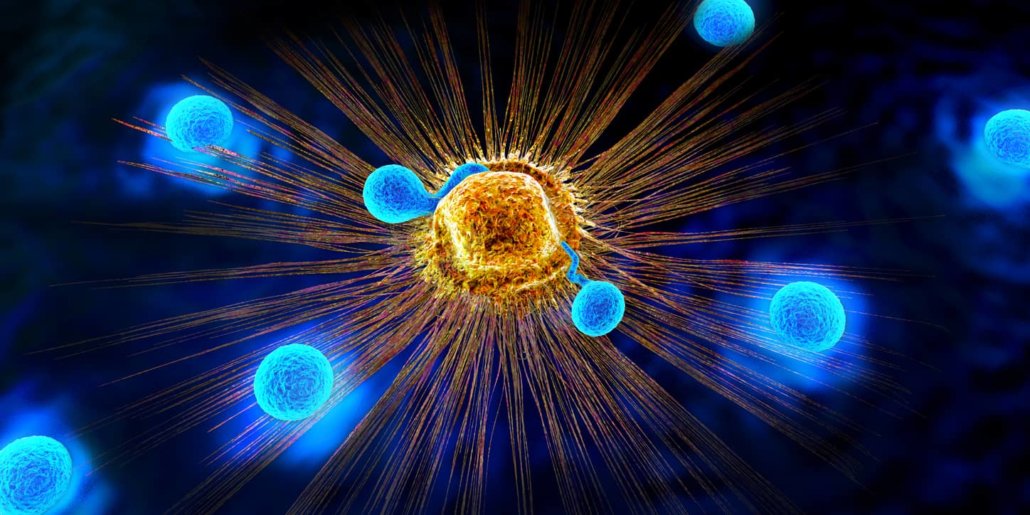Lymph node metastases – complex origin
Lymph node metastases arise from metastases of the primary tumor. In this process, cancer cells separate from the main tumor, enter the lymph nodes via the bloodstream or the lymphatic system, settle there and grow into daughter tumors (metastases).
In most cases, the lymph nodes closest to the organ of the primary tumor are affected. They may also arise in lymph nodes that first filter lymph from the organ affected by the tumor.
Detecting metastases requires good diagnostics
Lymph node metastases would often go undetected if appropriate testing was not performed due to cancer follow-up. The different imaging methods can provide different information. Using CT, MRI and PET/CT, our specialists at Radiologie München make the appropriate diagnoses.
Where can you have lymph node metastases treated in Munich?
Lymph nodes are often an initial area for metastases. After determining the primary tumor, the treating physician decides on the possible treatment options for the lymph node metastases. Radiation therapy is also a possibility – our team of specialists at Radiologie München will be happy to take care of individual and optimized treatment planning.

How can lymph node metastases be treated?
Lymph node metastases are often treated together with the primary tumor. Daughter tumors are characterized by the fact that they consist of cells from the primary tumor. It is therefore important to determine this first, as some cancers respond better to certain forms of treatment than others. In addition to this criterion, the stage, size, spread of the metastases and the patient’s health status are also decisive for the choice of treatment.
Operation
If the primary tumor is already more advanced, it is usually no longer confined locally to the affected organ. Then the cancer cells spread to the surrounding tissue and lymph nodes. In this case, the surrounding lymph nodes are also removed during a surgical procedure to remove parts of the primary tumor. This removes nearby metastases at the same time. It also reduces the likelihood of further lymph node metastases forming there at a later stage if the cancer is advanced.
Chemotherapy
If surgery is not possible because the cancer stage is already too advanced or because the cancer has already spread too far in the body and several lymph nodes are affected, then lymph node metastases are usually treated with chemotherapy. The drugs used in chemotherapy (cytostatics) slow the growth and spread of cancer cells and prevent the formation and spread of metastases in the body.
Radiotherapy
If the therapy of the primary tumor with chemotherapy and/or radiotherapy shows good results, the probability is high that the lymph node metastases will also respond well to the treatment. The choice of the type of radiation depends, on the one hand, on the type of radiation of the primary tumour and, on the other hand, also on the size, number and spread of the metastases in the lymph nodes.
Comparatively large, few, singular metastases are usually irradiated with percutaneous radiotherapy (teletherapy) or stereotactic irradiation. In this procedure, a metastasis is irradiated selectively with high-energy rays from the outside through the skin. This method uses supportive modern imaging techniques to damage only the cancer cells and not the healthy surrounding tissue.
Other treatment options
Besides the mentioned methods, other therapies can be used to fight the metastases in the body. Anti-hormone therapy is used when cancer cells of the primary tumor grow due to hormones (e.g.: breast cancer, uterine body cancer or prostate cancer). In this therapy, the hormone effect is suppressed – with the aim that the cancer cells also grow more slowly.
Targeted therapy uses drugs that suppress tumor cell metabolic processes. Immunotherapy strengthens the body’s immune system in the fight against cancer.
What is the treatment process in our practices?
What do you need to pay attention to before, during and after treatment?
The first priority of any cancer treatment is always the therapy of the primary tumor. If the disease is already far advanced and lymph node metastases are detectable in the body, then these are usually treated in parallel. Whether a cure is possible or whether the treatment is palliative in nature depends on the stage of the cancer and the spread of the tumors in the body. Often, metastases are not detected until too late, when symptoms are noticeable.
In addition to timely early detection, follow-up care is also very important. Regular follow-up examinations enable the physician to react in time to a relapse (recurrence) and to initiate appropriate measures. Follow-up includes, but is not limited to, CT and/or MRI, oncologic examination, and examination of the patient’s general condition. In this conversation, the patient has the opportunity to talk with the doctor about improvements and deteriorations in his well-being.
What are the side effects of lymph node metastasis treatment?
Based on his diagnosis, the patient receives an individualized treatment plan to combat the primary tumor and lymph node metastases. Metastases are often associated with an advanced stage of cancer, so patients may suffer from pain and concomitant symptoms of cancer. The therapy is designed to curb cancer growth and relieve pain. And although this therapy is not intended to place undue stress on the patient, side effects may occur due to the individual treatment modalities.
In general, surgeries carry some risk. Especially in an advanced stage of cancer, the lymph nodes often have to be removed in addition to parts of the affected organ. Therefore, it is possible that the removal of certain organs or their parts may cause a malfunction in the body. In addition, reduced wound healing and inflammation may occur after surgery.
Chemotherapies attack fast-growing cells, both healthy and diseased. Therefore, the cytostatic drugs used attack not only the growth and spread of cancer cells, but also blood, skin and mucosal cells. The result can be overtiredness, a reduced immune system, hair loss, nausea, diarrhea and inflammation.
Radiation therapy can also result in these side effects, depending on the region of the body being treated, as radiation therapy also destroys healthy and diseased cells. Furthermore, skin inflammation in the irradiation field is also possible.




